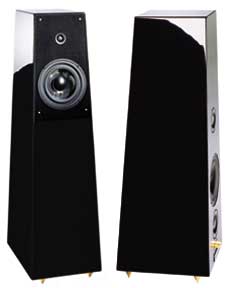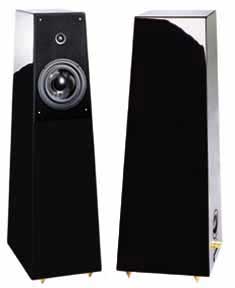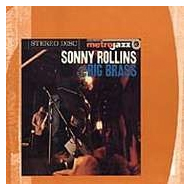You are reading the older HTML site
Positive Feedback ISSUE 9
october/november 2003
verity audio
X2 and X3 Tamino loudspeakers
as reviewed by Larry Cox

the X3 Tamino
LARRY COX'S SYSTEM LOUDSPEAKERS ELECTRONICS SOURCE CABLES ACCESSORIES
|
Canadian speaker manufacturer Verity Audio has its roots in the defunct Oracle turntable company. (The company now making Oracle turntables is a new company, even if it has the same principal participants and products.) Oracle turntables were beautiful to look at and highly recommended. I owned a Delphi Mk II for several years, and enjoyed both its looks and its sound. Oracle's first speaker was the product of Julien Pelchat and Bruno Bouchard, the principals of Verity Audio, so it is no surprise that all of the Verity Audio speakers are beautiful to behold as well as very solidly built.
The Taminos are Verity's new entry-level speakers. ASL Group, Verity's distributor in the United States, sent us two sets of speakers. One set is designed for "large" rooms and the other for "regular" sized rooms. Both are the same size, the difference being the number of drivers, I'll elucidate more fully. The large-room X3 speaker, which retails for $5990, has two SEAS 6.5-inch drivers, one in the front operating as a midrange driver and the other as a rear-firing bass driver. The woofer is parallel-coupled to the midrange and low-passed at 100 Hz. The small-room X2 Taminos, which retail for $4990, have a single 6.5-inch driver facing forward, with a rear-firing port. Both speakers have 3/4-inch Scan Speak soft-domed tweeters.

the X2 Tamino
Both speakers are finished in a beautiful black lacquer in an elongated semi-pyramidal form, the same shape as Verity's Fidelio and Parsifal. The finish is seamless, as though it is made of one piece of lacquered granite. The Taminos are relatively small speakers at 35 inches high, and did a nice job of disappearing visually in my room. My wife loved looking at them, and PFOer Jim Grudzien thought they were beautiful. I agree. The fit and finish are a delight to behold and the quality of the workmanship is admirable.
The speakers arrived in their own flight boxes (not a standard shipping method). When I opened the boxes, it was like opening King Tut's sarcophagus, except no Tut guts, just speakers and their accoutrements. The spikes and wiring terminals were placed in a separate plastic jewelry case with foam around them. Nice touch. When you're paying good money, it is pleasing and comforting to see that someone paid attention to the details.
As with the DALI Grand speakers I wrote about previously, the Taminos' rear-firing port presented something I had to adjust to. Verity states that the Taminos, like other Verity speakers, rely on room boundary reinforcement—i.e., they use the wall behind them to work with the rear port to tune the bass for your room. This translates into the need to find the proper distance from the front wall to obtain the correct reinforcement. As with all speakers with a rear-firing woofer, place the speaker too close and the bass is boomy, too far out and you miss out on bass. Ultimately, further out in the room is better than up against the wall. Despite the difference in the amount of air being pushed by the two different configurations, the large-room Taminos ended up about six inches farther out in the room than the small-room Taminos. So while there are special requirements for rear-firing ports, in this instance the requirements were about the same.
To repeat relevant information, my listening room is quite large. The room, which is actually my living room, is adjacent to an open dining room. Both are underneath a cathedral ceiling that slopes from fourteen feet to eight feet, with the speakers located at the lower end. Together, these two rooms create a 5500 cubic square foot space. That is a lot of space for two 6.5-inch woofers to fill, let alone one. Given my considerations about the speakers' fitness for my room, I opted to start listening to the large-room Taminos.
Before I describe my experience, I have to say that the sound character of the two speakers was very nearly the same, so if I don't announce that I'm speaking about the small-room Taminos, I'll be describing the large-room ones. With no warm up, break-in, or shamanistic practices, the speakers sounded delightful. Imaging immediately struck me as part of the booty that the Taminos brought with them.
Although 89 dB, the Taminos were sufficiently efficient to be driven by the Sophia Electric "Baby" amplifier. More power applied later by my 100-watt E.A.R. 509 Mk II monoblocks was appreciated, especially for bottom end speed, control, and depth, but the Taminos did well enough with the Baby that they could have been a short-term pairing. The Baby has a slightly golden glow, mostly in the midrange, but that glow can cause sunburn when the amp is pushed hard. Both Taminos were sufficiently transparent to tell you when the Baby was being pushed, and that more volume would not be welcome. The Taminos, when driven loudly by the Baby, could sound quite hard.
Realistically, the Taminos want more like 50 watts of power, especially in a room like mine. My E.A.R. 509s, paired to my E.A.R. 864 preamp, made for a huge step up in listening quality, one you'd expect when increasing the cost and quality of the products surrounding the Taminos. The first thing I'd say about the Taminos when matched to my reference system is that they did a nice job filling my room, which is saying something. The DALI Grands, with considerably more square inches of woofer, did an even better job, although at the cost of visually dominating the room. The Taminos resolved my worry that I'll end up with huge speakers in my house. Let me just take a moment for an aside on this speaker size thing.
I love music. When my system has been down, I could subscribe to having a "need" for music, not quite equal to the need for food, but as much as any other elective activity in which I participate. No music, Larry unhappy. No hiking, Larry unhappy. No inline skating, Larry unhappy. No quiet time, Larry unhappy.
This sort of unhappy makes me withdraw a little, and makes me wonder, "Whose life is this, anyway? I don't get to do the things I like to do." Music is important to me. This said, I am not willing to give over my house to audio colossi to have high-quality sound. I've got other things in my life than listening to music, thank God!
I know that if you want true 20 Hz-20 kHz bandwidth, you'll probably end up with really big speakers, and likely big amps to drive them. I'll pass. I'll do without the extra 10 or 20 cycles, or maybe cheat and get a powered subwoofer, but if a system can do the rest of the spectrum, fill a room, and allow more than stereo to exist in a multi-use room, for me that's the trick. Verity Audio's designs are a welcome part of lifestyles that include, but aren't only about music or audio.
Some products you plop into your system and have an immediate response. The Taminos didn't do that. They nestled into my system and simply went about their business, playing music without a clearly evident sound of their own.
Verity claims bass down to 40 Hz with both Taminos. Bass on both was full rather than dry and desiccated. While lots of bass was present, it wasn't the sort that flaps your pants legs. Cranking Yello's Oh, Yeah! brought out plenty of bass, with a sense that there was more below its range, but not a lot. With the small-room Taminos, bass was tighter and faster than with the large-room ones, giving a more "reference monitor" type of performance in the bass region.
The opening track, "Hawaii 78 Introduction," from Facing Future by Israel Kamakawiwo'ole, was beyond the capability of the Taminos. The drums on this track extend down to about 25 Hz AND their volume is down in level relative to the rest of the mix. Both Taminos hinted at the presence of really deep bass, without bringing it in at the correct level. With piano, however, like that on Norah Jones' Come Away With Me, the bottom end could do its thing with timbre appropriately rendered. Ditto for the bass strings of Steve Forbert's Evergreen Boy, and the kick drum on the opening track.
 The Taminos' top end was extended, albeit not always as open or airy as the
tweeter that you can find on, say, Avalon speakers. I don't know whether to lay that at
the feet of the Taminos or my system. The Metro Jazz remix of Sonny Rollins' rendition of
"Grand Street" on Sonny Rollins and the Big Brass (Verve Master Edition
312 557 545-2) pumps out some extended, open, and airy treble, and the Taminos replayed
that well. The trumpet's blat and blare lets you know that brass is stretching into its
upper regions. The Taminos took me there with nary a misstep. The Taminos declined to etch
the brass, offering a very life-like music experience. Every little tendril of blat that
was reproduced had its own filigree, and was intact, undistorted, and unetched.
The Taminos' top end was extended, albeit not always as open or airy as the
tweeter that you can find on, say, Avalon speakers. I don't know whether to lay that at
the feet of the Taminos or my system. The Metro Jazz remix of Sonny Rollins' rendition of
"Grand Street" on Sonny Rollins and the Big Brass (Verve Master Edition
312 557 545-2) pumps out some extended, open, and airy treble, and the Taminos replayed
that well. The trumpet's blat and blare lets you know that brass is stretching into its
upper regions. The Taminos took me there with nary a misstep. The Taminos declined to etch
the brass, offering a very life-like music experience. Every little tendril of blat that
was reproduced had its own filigree, and was intact, undistorted, and unetched.
Since most of the music I like to listen to is acoustic, 20 Hz and 20 kHz aren't important parts of my listening realm. It's the midrange that does it for me. I warmed to the Taminos' rendering of Norah Jones' genuine, "unslicked-up" singing, giving her a breathy quality that allowed her to sound very feminine. The Indigo Girls were seamlessly matched in harmony on "Least Complicated" from their Swamp Ophelia CD. The speakers' excellent rendering of their individual voices wrapping around a harmony like vines around a pole was a delight.
I have been listening to a great CD sampler from Ensemble Audio of Switzerland. This is a collection of exceptionally well-recorded acoustic music from Simax, a European label. Whether you like every track or not, you'll appreciate their capacity to check out your system, particularly the Benjamin Britten track, A Ceremony of Carols (Simax Classics PSC 1106). This music was written for a boys choir, but is performed by women. The track is recorded with the natural ringing that can occur in vocals, and that can overwhelm the listener. The Taminos did this admirably, without adding their own distortion. On the other hand, Israel Kamakawiwo'ole sounded like the 800-pound angel that he was, while retaining his earthly male character. Slightly lower in the male vocal range, the Taminos rendered Steve Forbert's distinctive nasal, gravelly voice very well, pulling in a dash of his angst and tomfoolery.
I toyed with purchasing one of the Taminos. If I had, I'd have opted for the large-room Taminos. Why? Because in my room, there was just more bass, even if the presentation was ever so slightly less taut. There was simply more sound volume. The slightly less taut sound would not be a problem, I think, if I were merely listening to music and not acting as a reviewer. The small-room Taminos sounded slightly leaner. The bottom end was tight and controlled without becoming desiccated. Their tautness and control translated into a more transparent midrange. I expect that the midrange was the same as that of the large-room Taminos but that there was less bass overhang to obscure it.
I borrowed a Hsu subwoofer and 250-watt amplifier which I matched up to the small-room Taminos. This gave a full, deep, authoritative sound that could be considered full range, and was beyond that of the large-room Taminos. My wife was a little shocked to see the four-foot-high Hsu cylinder in the corner of the room, but enjoyed the addition that the Hsu offered. The acoustic bass in Israel's "Hawaii 78 Introduction" now showed up well, though still not as well as I remember it on other speakers I have heard. On the Hsu/Verity setup, the volume needed to be fairly high to let the bass show up distinctly.
Using a graph to measure the Taminos would have earned them a solid recommendation. I'll give them that. I really enjoyed them. While I thought about buying them, I did not. Why? Two things kept me from them. One was finances. I opted to have a fabulous vacation instead. The second reason is harder to articulate. It seemed that there was a slight compression in the midrange that imparted a slightly—and I really mean slightly—hard quality to the sound. What I have been looking for in a speaker is a little more sweetness, a lighter touch, than my reference speakers provide. I didn't get it with the Taminos. The sound was close to that of my reference speakers without retaining the same almost otherworldly capacity to swing macrodynamics.
I'm not sure that the problem doesn't lie somewhere else in my system, specifically my Audio Note 3.1x CD player. Compared to the Metronome CD1V Signature player, the Audio Note went from loud to soft faster, but the Metronome did a much better job of leaving room for music's smaller, softer dynamic swings. By comparison, the Audio Note was slightly more forced, and this could have played a role in the Veritys' sound. Regrettably, I didn't have multiple CD players lying around to test out this theory.
What you should take away from this review is that the Verity Audio Taminos are well-executed speakers. They are beautiful to look at and to listen to. Their bass reproduction is more than acceptable, with a realistic rendering of bass timbre, an extended though not airy treble, and a midrange that has a clarity and transparency that is worthy of its competition and worthy of your attention. Although I didn't purchase the Taminos, I can recommend them. They are musical transducers that will fit nicely into beautiful homes. Larry Cox
Tamino
loudspeakers
Retail: $5995 for the X3 and $4995 for the X2.
Verity Audio, Inc.
150-1005 Saint-Jean-Baptiste
Quebec, QC G2E 5L1 Canada
TEL: 418. 682. 9940
email address: [email protected]
web address: www.verityaudio.com
US Importer
Audiophile Systems, Ltd.
8709 Castle Park Drive
Indianapolis, IN 46256
Toll Free: 1. 888. 272. 2658
TEL: 317. 841. 4100
email address: [email protected]
web address: www.audiophilesystems.com
